Mund35ane-cha11nnel.xyz ads (scam) - Free Guide
Mund35ane-cha11nnel.xyz ads Removal Guide
What is Mund35ane-cha11nnel.xyz ads?
Mund35ane-cha11nnel.xyz is a fake website disguised as a warning from McAfee
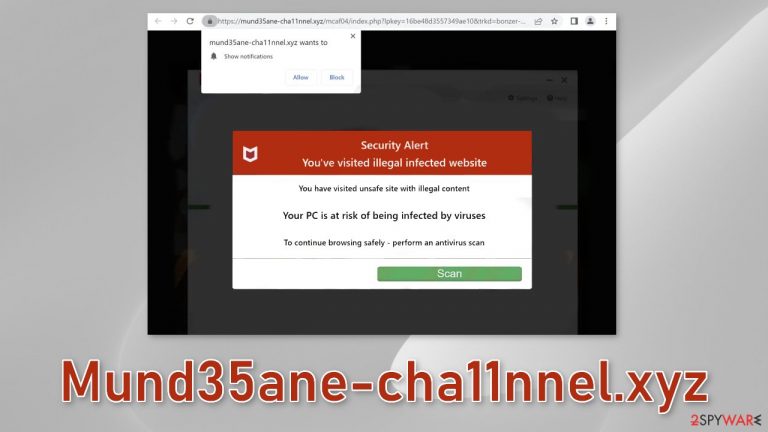
Mund35ane-cha11nnel.xyz is a bogus website that tries to trick people into thinking they have received a security alert from McAfee which is a well-known security suite. The page uses scare tactics and flashes intimidating messages to get users to act without thinking.
According to the site, the computer is infected with 5 viruses and people need to renew their subscription to stay protected. However, it is clear that McAfee has nothing to do with this fraudulent campaign and it is completely fabricated by crooks.
Scammers can try to lure out people's personal information or fool them into downloading PUPs (potentially unwanted programs),[1] and malware. This can result in monetary losses, identity theft, and operating system damage. The page can also cause fake security alert spam that can lead to dangerous pages.
| NAME | Mund35ane-cha11nnel.xyz |
| TYPE | Phishing attempt; adware |
| SYMPTOMS | The website can start sending pop-ups that say the system is infected with viruses |
| DISTRIBUTION | Shady websites, deceptive ads, freeware installations |
| DANGERS | The promoted software can actually be a PUP or malware which could lead to monetary losses |
| ELIMINATION | Disable pop-ups via browser settings and scan your system for adware with professional security tools |
| FURTHER STEPS | Use FortectIntego to fix any remaining damage and optimize the machine |
Distribution techniques
Pages like Mund35ane-cha11nnel.xyz are rarely found in search results. Most often they are promoted on other shady sites that engage in illegal activities because they are unregulated. They are full of deceptive ads and sneaky redirects. That is why it is so important to be careful online and not click on random links.
You could have also ended up on the site through pop-ups generated by adware.[2] As we mentioned before, many of these fake antivirus pages produce pop-ups that say users' computers are infected by viruses. If you have clicked on one of these pop-ups, you could have been redirected to the site.
Freeware installations can cause virus infections
Adware is most often spread on freeware[3] distribution sites. Because the owners do not make any money from the software itself, they include additional programs in the installers which they do not disclose on their sites. Most people rush through the installation process and skip the steps, that is how they do not notice PUPs (potentially unwanted programs).
To avoid this in the future, we suggest always choosing the “Custom” or “Advanced” installation method and going through all the stages carefully. Read the Terms of Use and Privacy Policy to learn what the application will be able to do on your system and what information will it collect. The most important part is to look at the file list and untick the boxes next to any programs that seem unrelated.
Block push notifications and clear your browsers
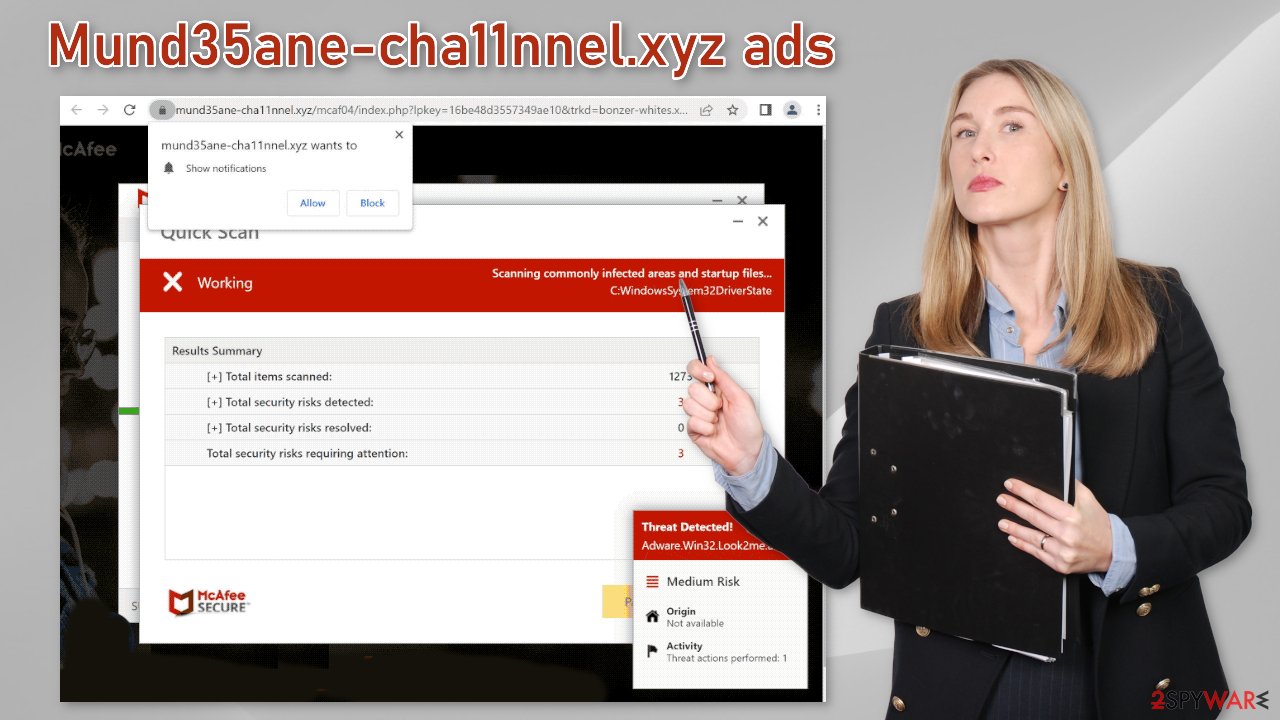
If you see pop-ups appearing in the corner of the screen that say your system is infected with Trojans, ransomware, and other types of malware you need to disable them in your browser settings. If you click on these pop-ups they can lead to dangerous pages.
Push notifications are based on a subscription model, so you must disable them manually. After the removal is complete, we recommend using FortectIntego repair tool to clear your browsers. Almost every website you visit uses cookies[4] to track your browsing activity, like the pages you visit, links you click on, and purchases you make. This data can be sold to advertising networks and used to target you with ads even more.
To stop the pop-up ads from appearing, follow our step-by-step guide for Chrome, Firefox, Safari, and MS Edge:
Google Chrome (desktop):
- Open Google Chrome browser and go to Menu > Settings.
- Scroll down and click on Advanced.
- Locate the Privacy and security section and pick Site Settings > Notifications.
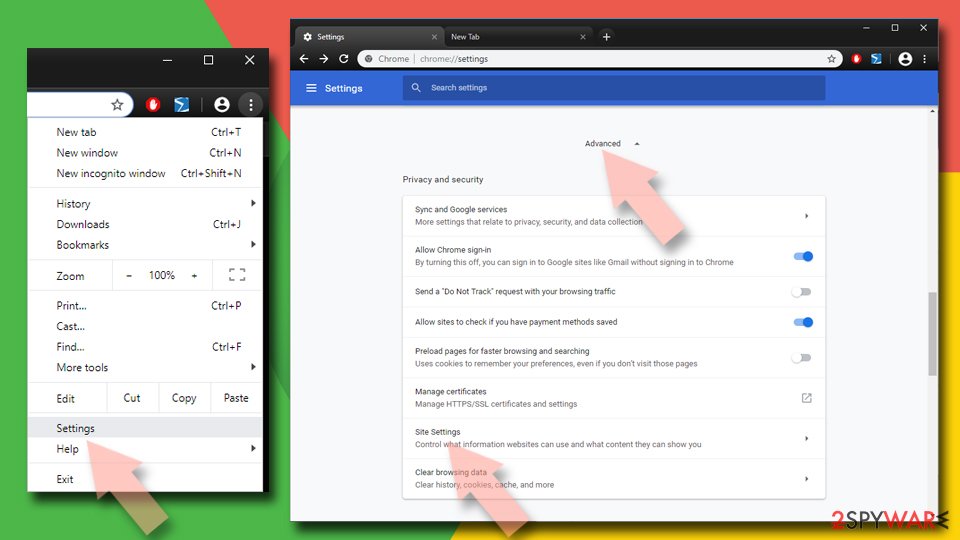
- Look at the Allow section and look for a suspicious URL.
- Click the three vertical dots next to it and pick Block. This should remove unwanted notifications from Google Chrome.
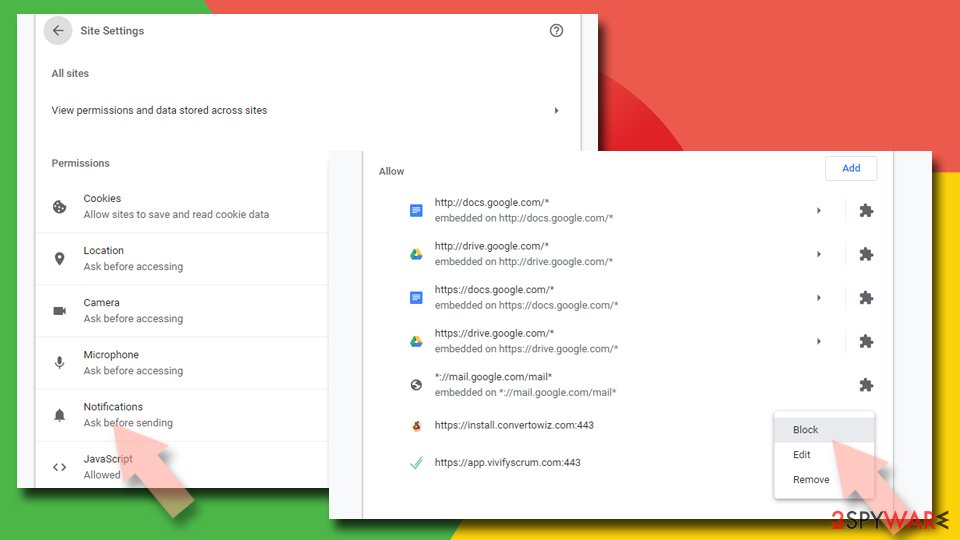
Google Chrome (Android):
- Open Google Chrome and tap on Settings (three vertical dots).
- Select Notifications.
- Scroll down to Sites section.
- Locate the unwanted URL and toggle the button to the left (Off setting).
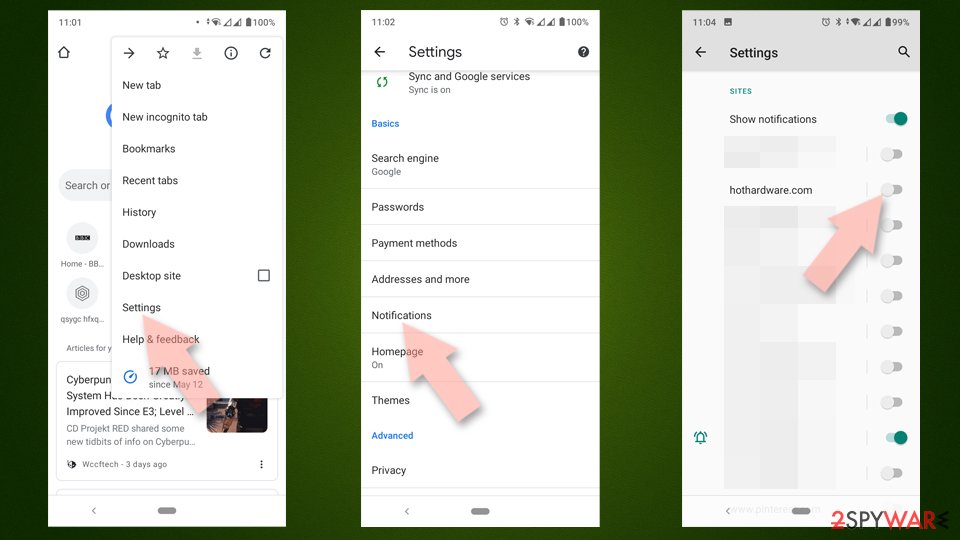
Mozilla Firefox:
- Open Mozilla Firefox and go to Menu > Options.
- Click on Privacy & Security section.
- Under Permissions, you should be able to see Notifications. Click Settings button next to it.
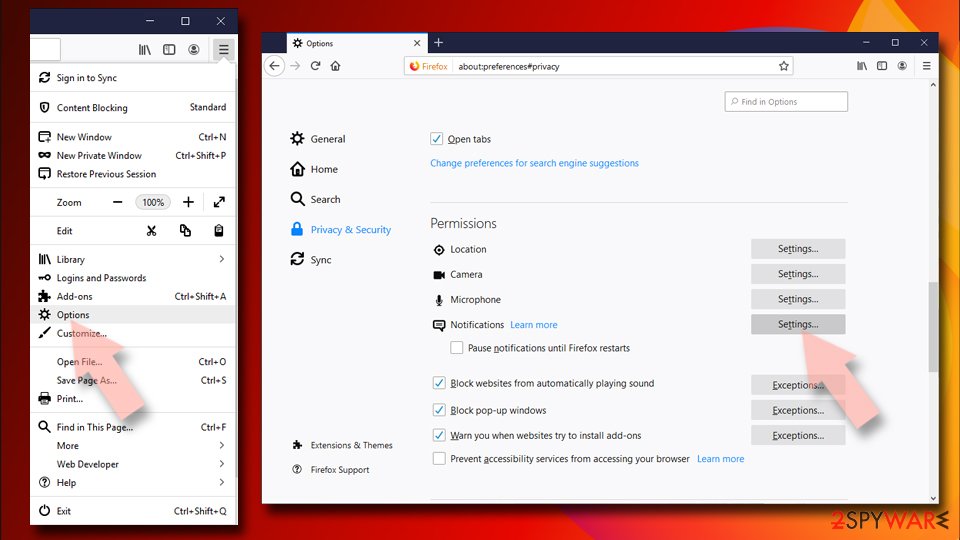
- In the Settings – Notification Permissions window, click on the drop-down menu by the URL in question.
- Select Block and then click on Save Changes. This should remove unwanted notifications from Mozilla Firefox.
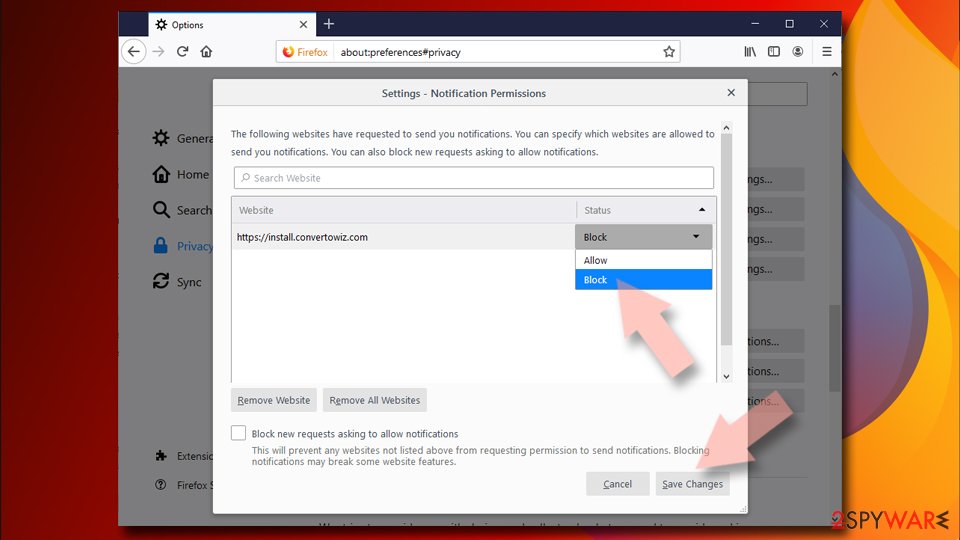
Safari:
- Click on Safari > Preferences…
- Go to Websites tab and, under General, select Notifications.
- Select the web address in question, click the drop-down menu and select Deny.
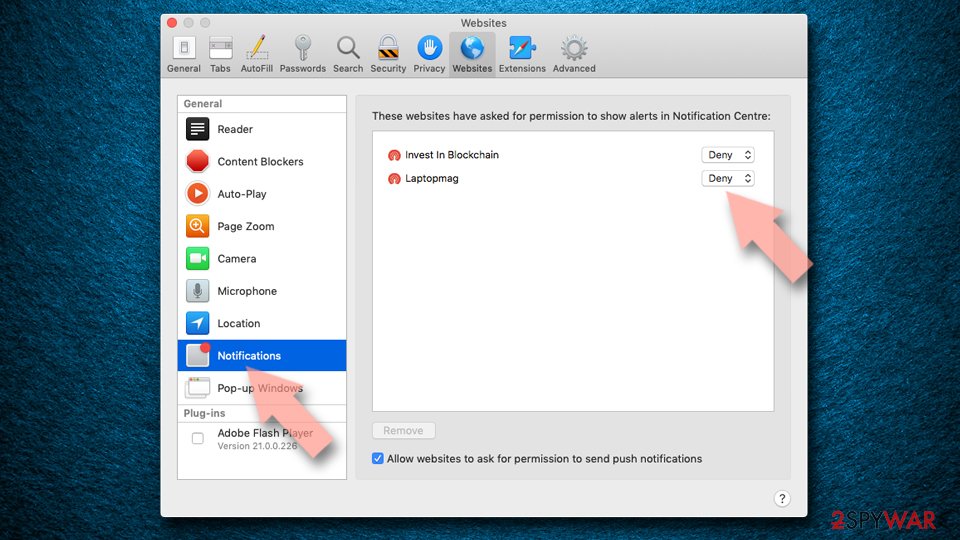
MS Edge:
- Open Microsoft Edge, and click the Settings and more button (three horizontal dots) at the top-right of the window.
- Select Settings and then go to Advanced.
- Under Website permissions, pick Manage permissions and select the URL in question.
- Toggle the switch to the left to turn notifications off on Microsoft Edge.

MS Edge (Chromium):
- Open Microsoft Edge, and go to Settings.
- Select Site permissions.
- Go to Notifications on the right.
- Under Allow, you will find the unwanted entry.
- Click on More actions and select Block.
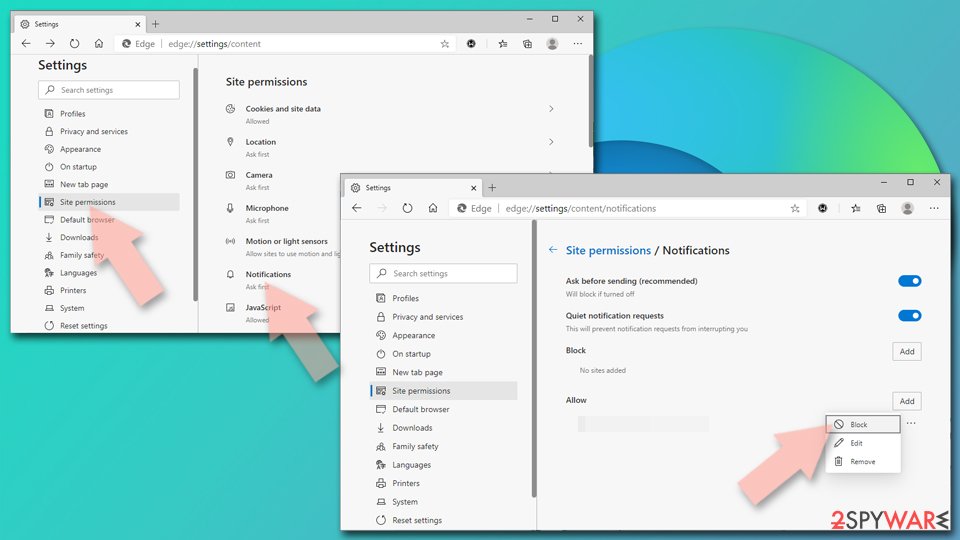
Scan your system for adware
If you disabled push notifications but still experience unwanted symptoms like unexpected redirects and an increased amount of commercial content, you should scan your system for adware. We suggest using trusted professional security tools SpyHunter 5Combo Cleaner or Malwarebytes to scan your machine automatically. It should detect most suspicious apps and remove them successfully.
Of course, you can also remove a PUA manually, but it is unknown which particular app could be causing annoying behavior, so removing it can be difficult if you do not have experience. You risk deleting the wrong files or not uninstalling the software fully. If you know which program is at fault, use our guide to help you uninstall it:
Windows 10/8:
- Enter Control Panel into Windows search box and hit Enter or click on the search result.
- Under Programs, select Uninstall a program.

- From the list, find the entry of the suspicious program.
- Right-click on the application and select Uninstall.
- If User Account Control shows up, click Yes.
- Wait till uninstallation process is complete and click OK.

Windows 7/XP:
- Click on Windows Start > Control Panel located on the right pane (if you are Windows XP user, click on Add/Remove Programs).
- In Control Panel, select Programs > Uninstall a program.

- Pick the unwanted application by clicking on it once.
- At the top, click Uninstall/Change.
- In the confirmation prompt, pick Yes.
- Click OK once the removal process is finished.
Mac:
- From the menu bar, select Go > Applications.
- In the Applications folder, look for all related entries.
- Click on the app and drag it to Trash (or right-click and pick Move to Trash)

To fully remove an unwanted app, you need to access Application Support, LaunchAgents, and LaunchDaemons folders and delete relevant files:
- Select Go > Go to Folder.
- Enter /Library/Application Support and click Go or press Enter.
- In the Application Support folder, look for any dubious entries and then delete them.
- Now enter /Library/LaunchAgents and /Library/LaunchDaemons folders the same way and terminate all the related .plist files.

How to prevent from getting adware
Choose a proper web browser and improve your safety with a VPN tool
Online spying has got momentum in recent years and people are getting more and more interested in how to protect their privacy online. One of the basic means to add a layer of security – choose the most private and secure web browser. Although web browsers can't grant full privacy protection and security, some of them are much better at sandboxing, HTTPS upgrading, active content blocking, tracking blocking, phishing protection, and similar privacy-oriented features. However, if you want true anonymity, we suggest you employ a powerful Private Internet Access VPN – it can encrypt all the traffic that comes and goes out of your computer, preventing tracking completely.
Lost your files? Use data recovery software
While some files located on any computer are replaceable or useless, others can be extremely valuable. Family photos, work documents, school projects – these are types of files that we don't want to lose. Unfortunately, there are many ways how unexpected data loss can occur: power cuts, Blue Screen of Death errors, hardware failures, crypto-malware attack, or even accidental deletion.
To ensure that all the files remain intact, you should prepare regular data backups. You can choose cloud-based or physical copies you could restore from later in case of a disaster. If your backups were lost as well or you never bothered to prepare any, Data Recovery Pro can be your only hope to retrieve your invaluable files.
- ^ Wendy Zamora. What is a PUP? – How to avoid potentially unwanted programs. Malwarebytes. Online Safety Tips, Tricks and How-Tos.
- ^ Adware. ikipedia, the free encyclopedia.
- ^ Tim Fisher. What Is Freeware?. Lifewire. Internet, Networking and Security Blog.
- ^ Chris Maus. What Are Cookies and Are They Dangerous?. Qkey. Secure Online Payment Providers.
